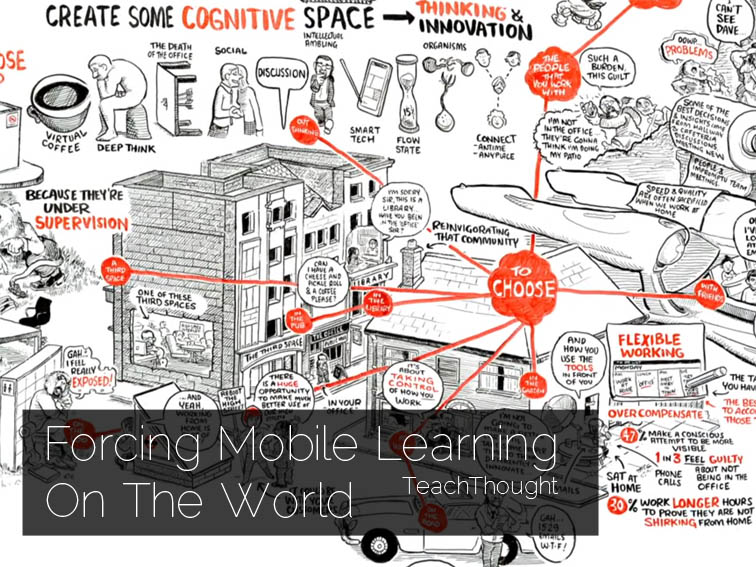
Forcing Mobile Learning On The World
by Terry Heick
In education, we tend to think of mobile learning as learning in classrooms with tablets and smartphones. And that’s part of it.
Students being able to untether themselves from desks is an extraordinary development that brings with it all kinds of possibility. The benefit of mobile learning thus far has been primarily personalization. Students that can move and access content on individual devices can have that content personalized for them in a just-in-time, just-for-me context. But we stifle the potential gains of technology and mobile learning when we simply shift the tether from the desk to the classroom walls.
This is only the beginning of how students will eventually use technology to inform their work and study. It’s true that mobile learning can solve the problem of creative spaces, but that misses the point of mobility–to go where you want, when you want, to be with who you want to be with to do the work you believe needs to be done. And to further combine local resources and spaces with digital networks and communities to do your best work.
Our current thinking that huddles groups of students in small rooms in brick buildings is based on problems of technology and assembly that are no longer problems. This likely sounds like education dreaming, but only because we’re stuck in old thinking patterns. Yes, it’s true that a 6-year-old can’t grab his tablet and hop on his big wheel and ride down to Starbucks to ‘think.’
Clearly we need systems (of some kind) to manage how we build literacy skills in children. Past that, compared to what’s possible in learning, schools–in their current form–quickly lose their credibility.
We Create What We Believe We Need
Our current social structures don’t lend themselves well to the whole idea of mobile learning because they’ve never had to.
We don’t need to hunt anymore because there are groceries and restaurants. We (literally) don’t make room for apprenticeships and creative learning spaces for children and ways for teens to meaningfully connect in communities because we have schools. Which is as crazy as it sounds.
There will be a (perhaps extended) period of adjustment as we rethink the physical spaces in the large buildings we call schools, and how they relate to the communities around them. Technology will create this opportunity, but it will be up to society–which may start with leadership from the schools–to manage the inevitable challenges of this kind of change and make it all sustainable and hunky-dory.
In truth, the same applies to game-based learning, project-based learning, and so many other trends that our ‘clients’–parents, families, organizations, and businesses–don’t understand. Because it is not technology, but rather the communities and their inherent problems, creativity, and ‘human resources’ that are the sleeping giants in education.
In the video below, Dave Coplin, Chief Envisioning Officer at Microsoft, explores this idea through the lens not of learning, but work. His take is that in work, productivity is not the solution but the problem. We’ve taken an industrialized approach to our work, which has damaged our creativity, innovation, and trust. (To the point where over 71% of Americans claim to be unhappy with their work–which is a staggering number.)
This post was originally written in 2016 and updated several times, most recently in 2020

